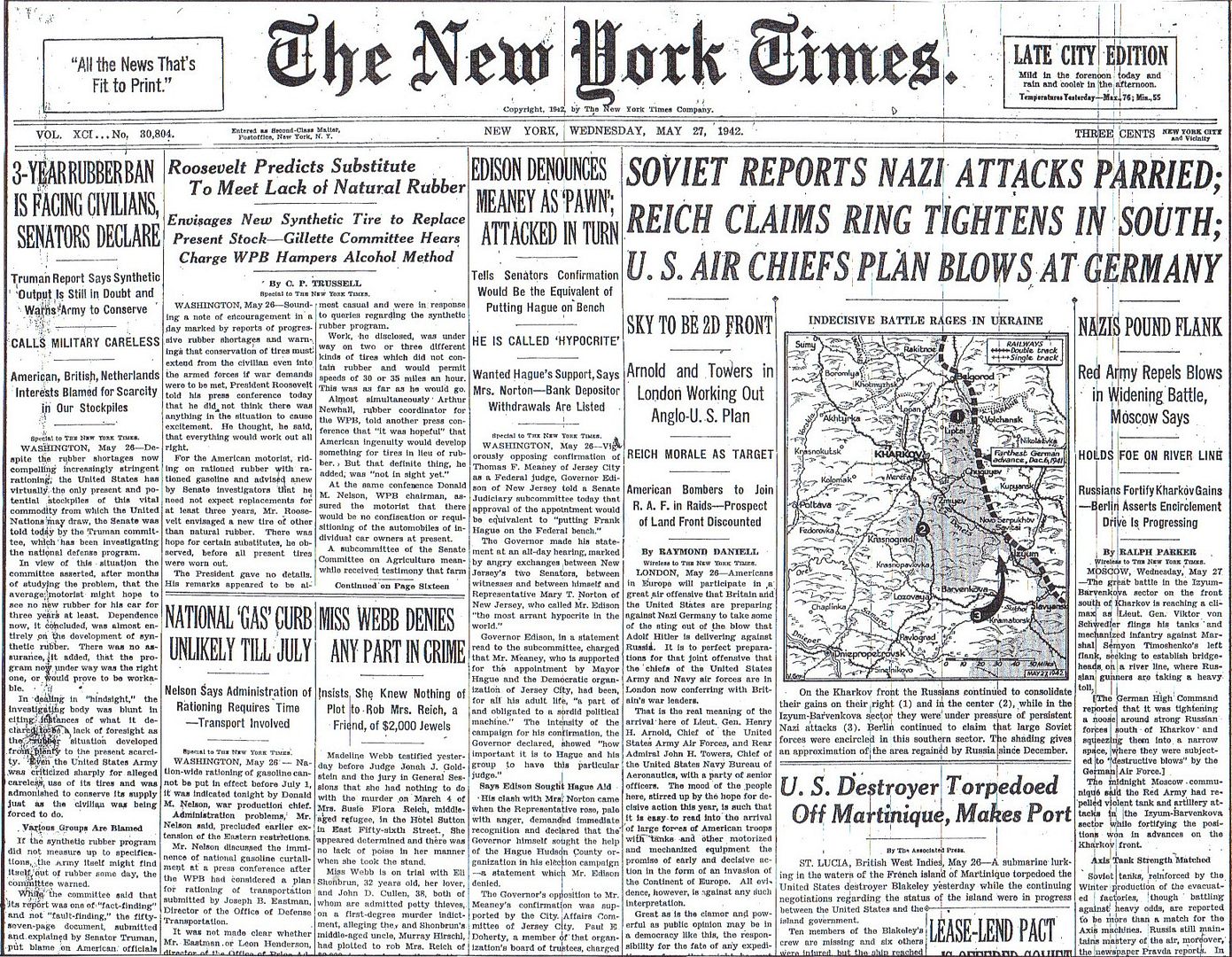
Posted on 05/27/2012 5:24:29 AM PDT by Homer_J_Simpson

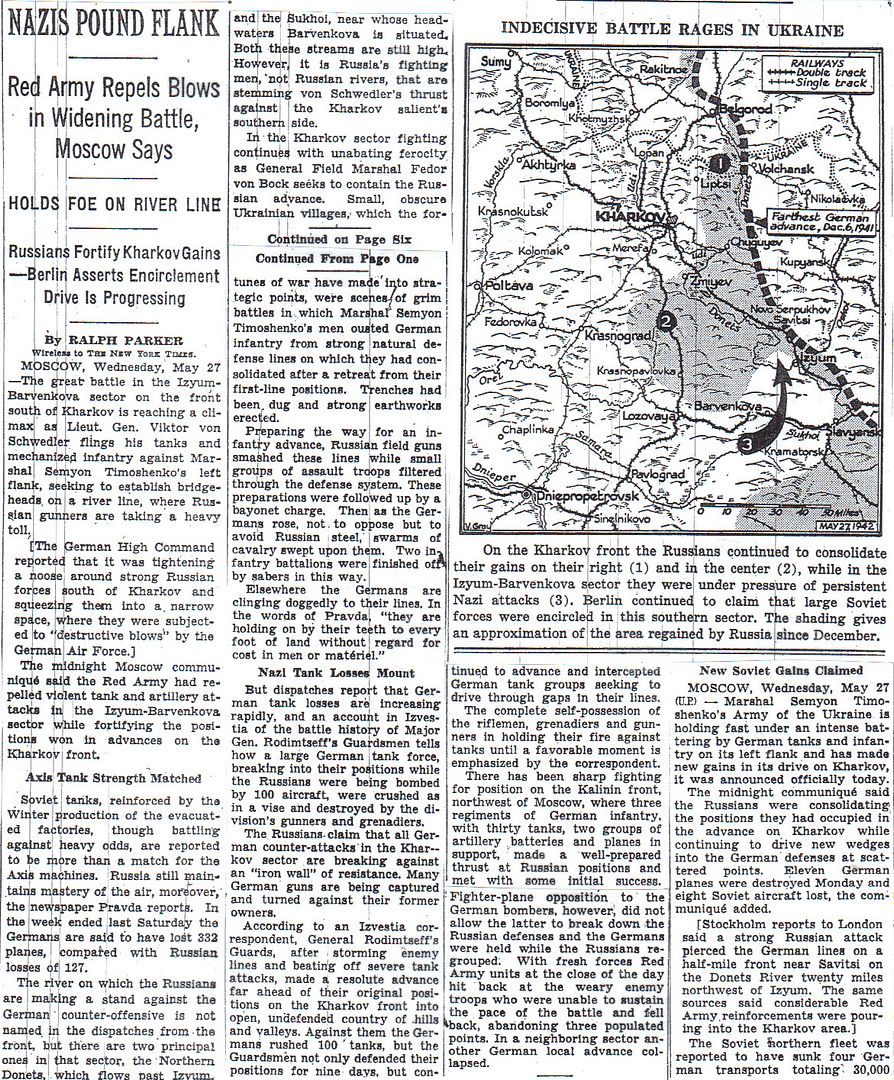

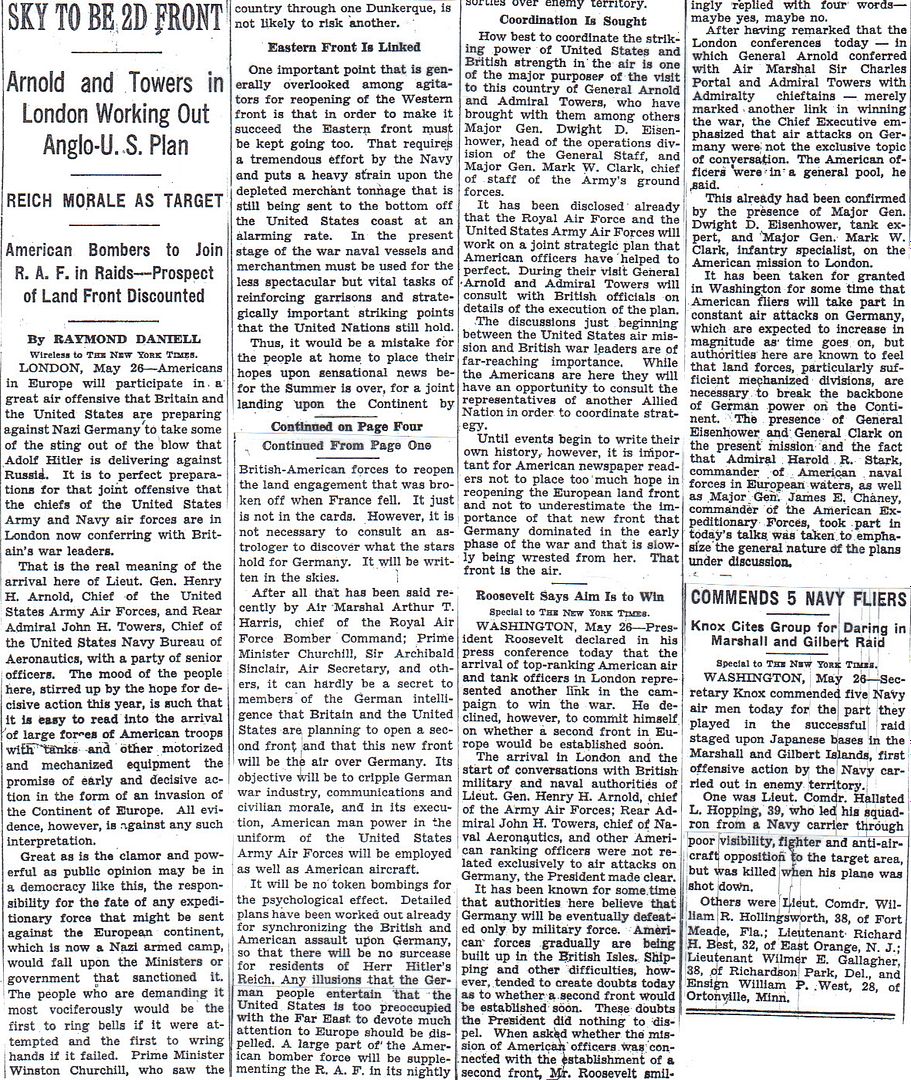
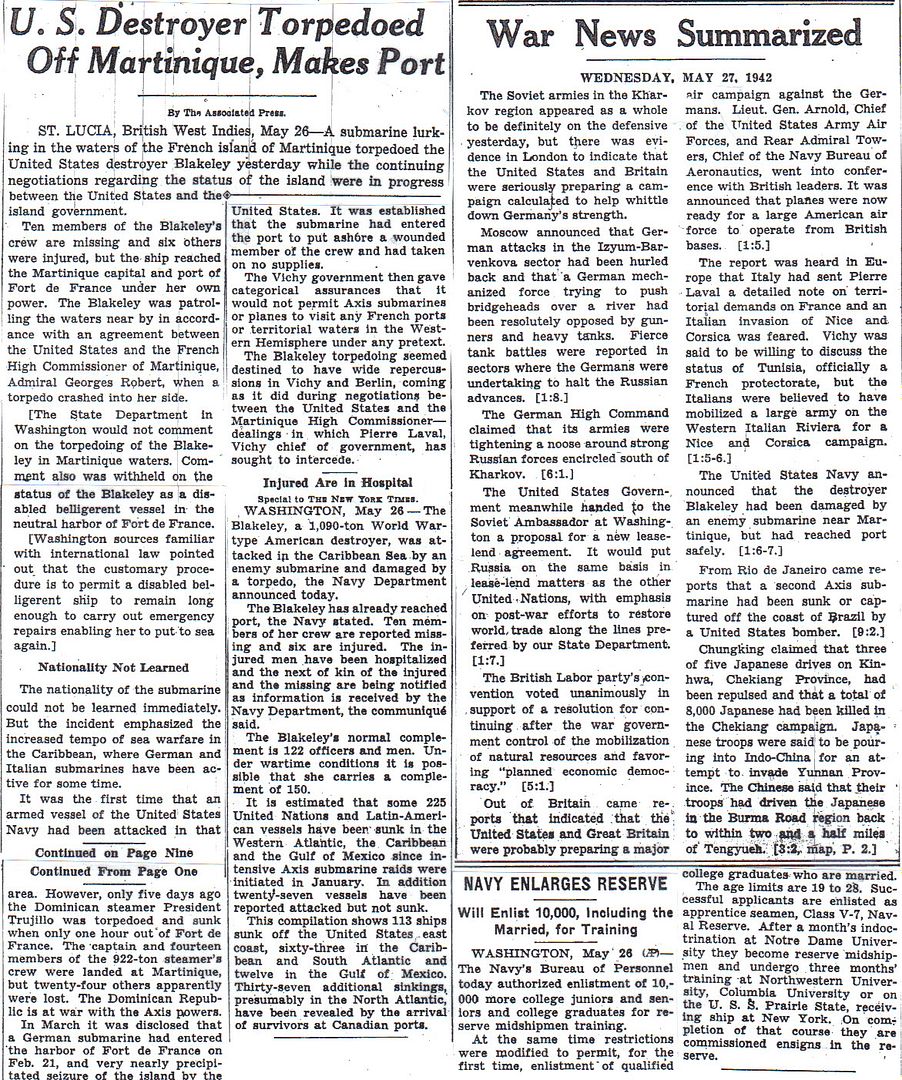
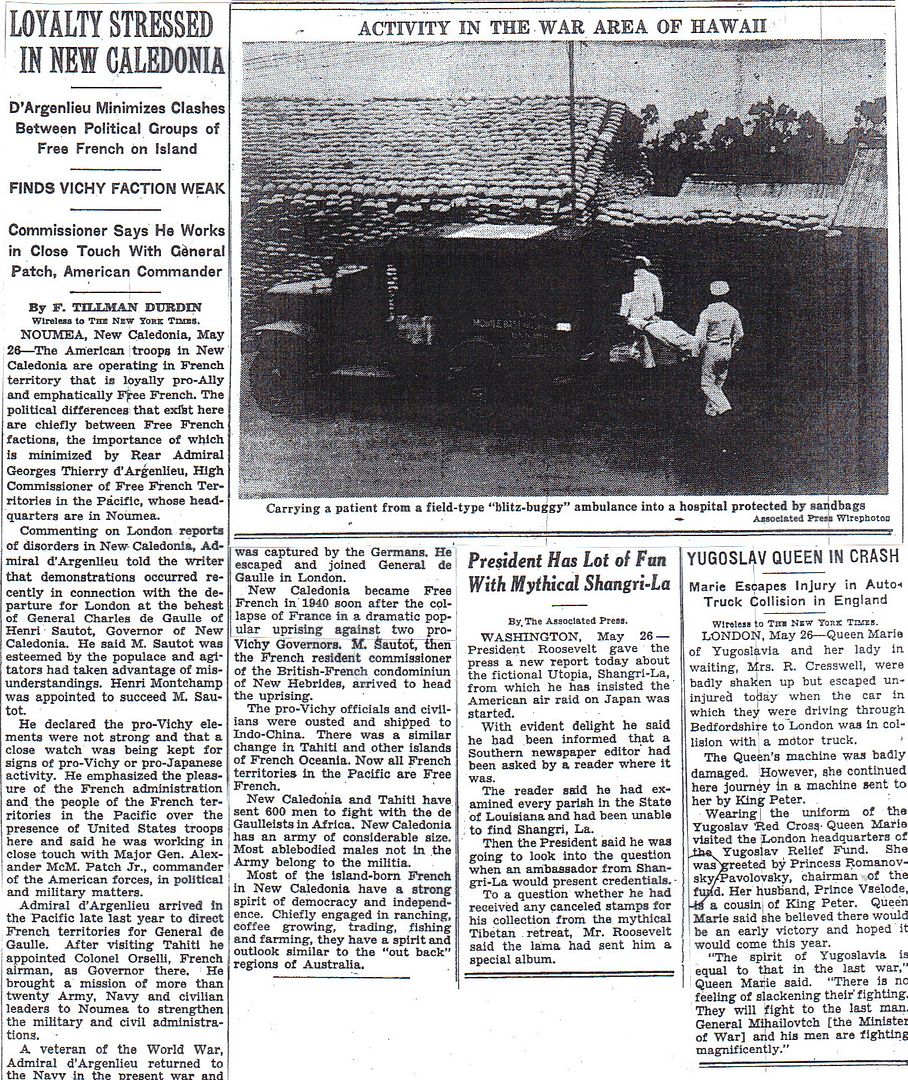
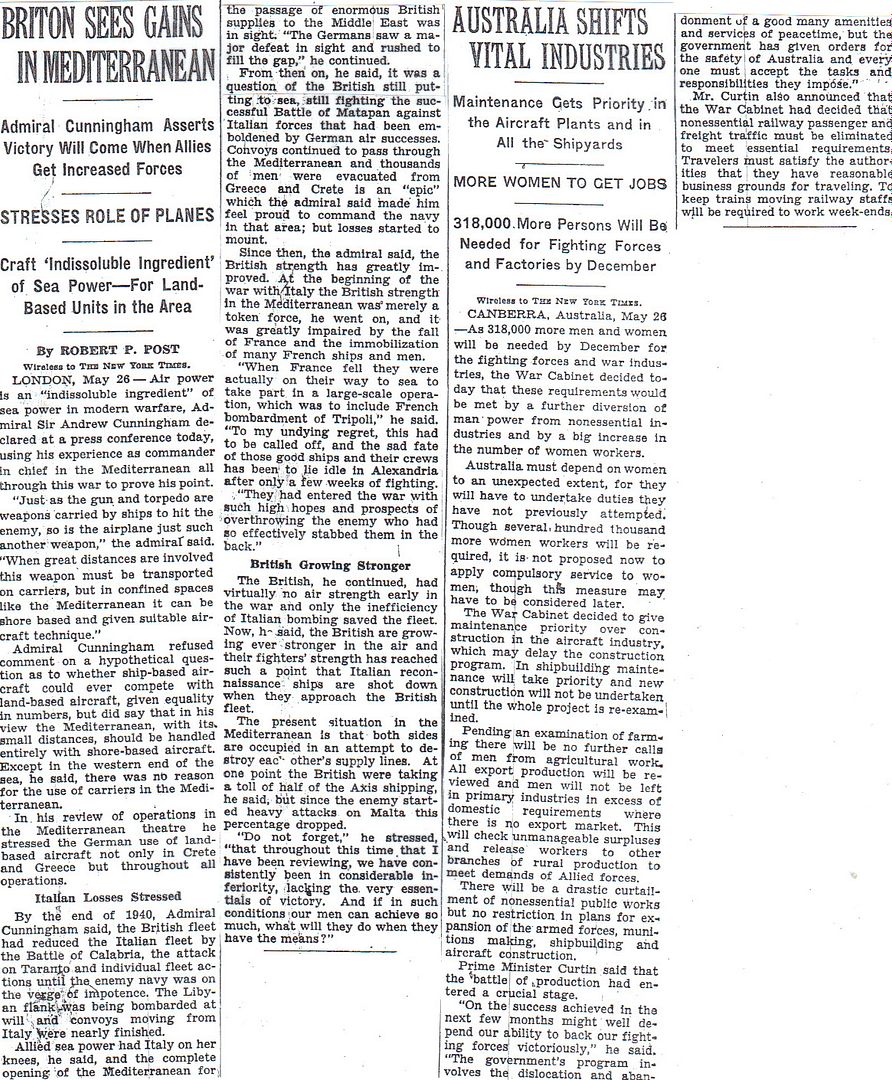
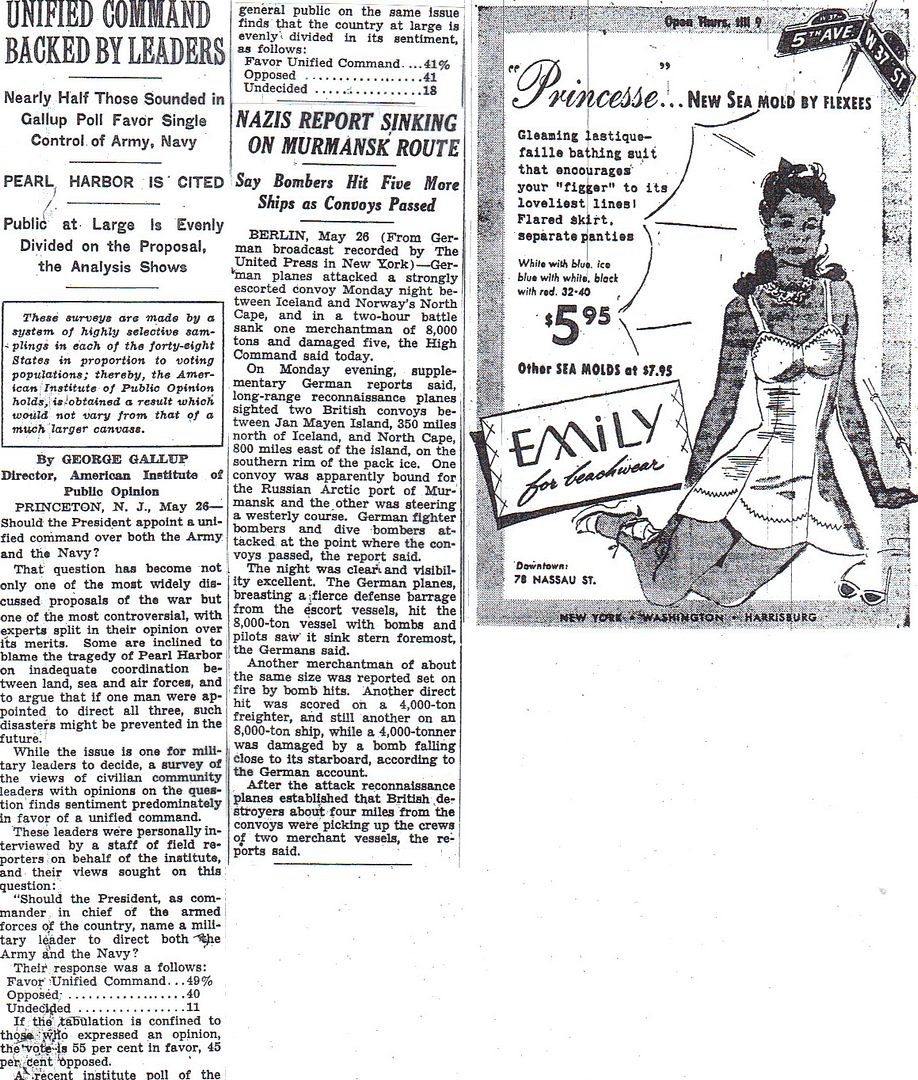
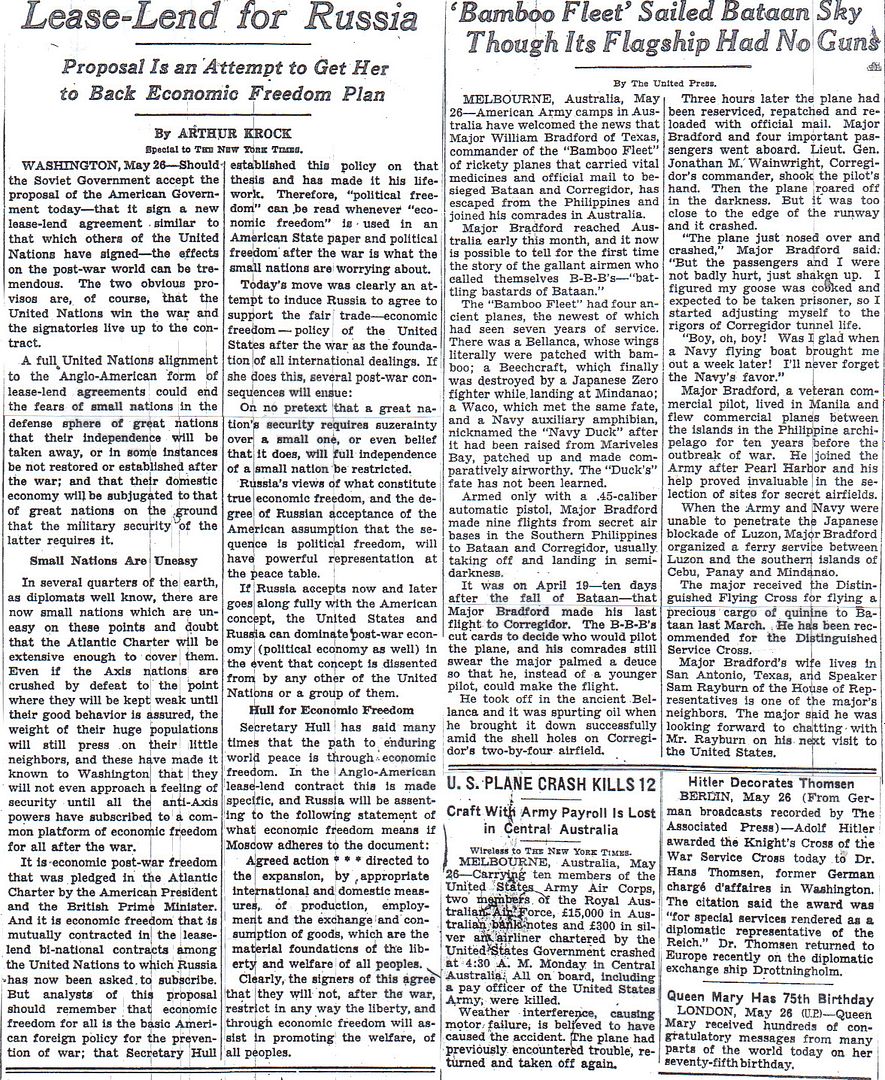
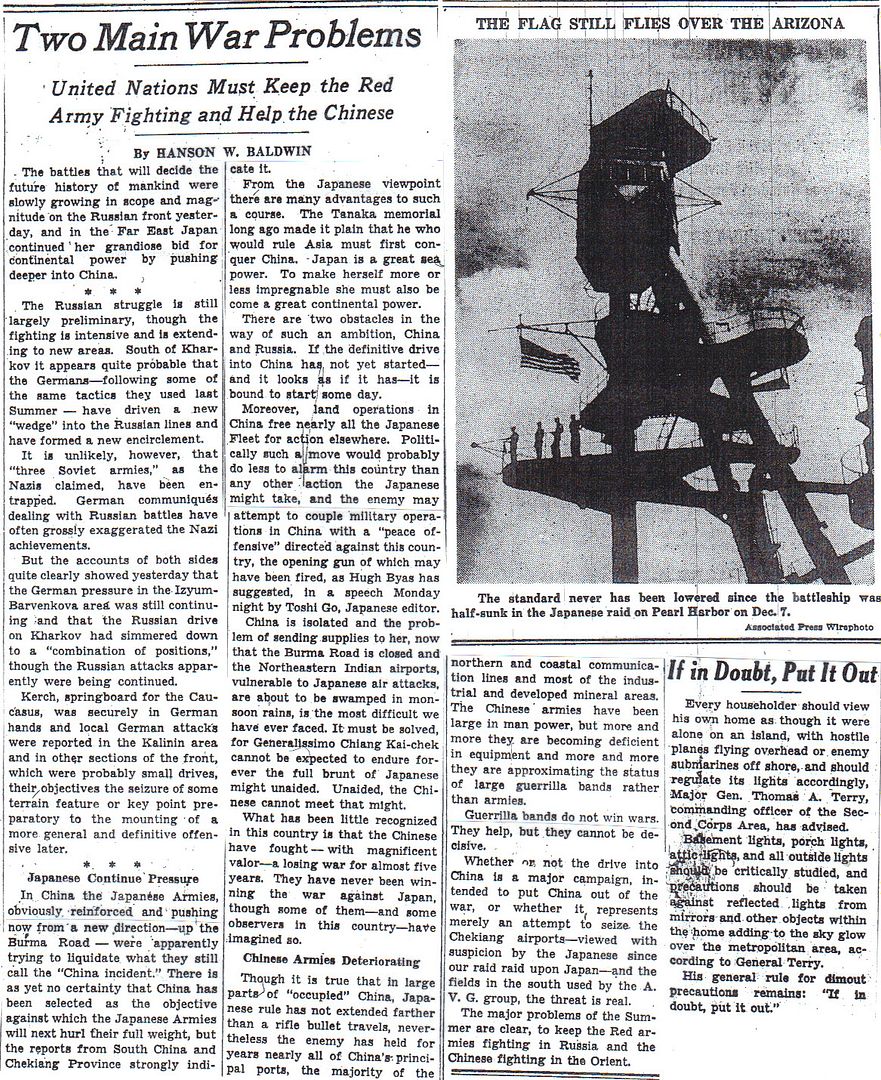
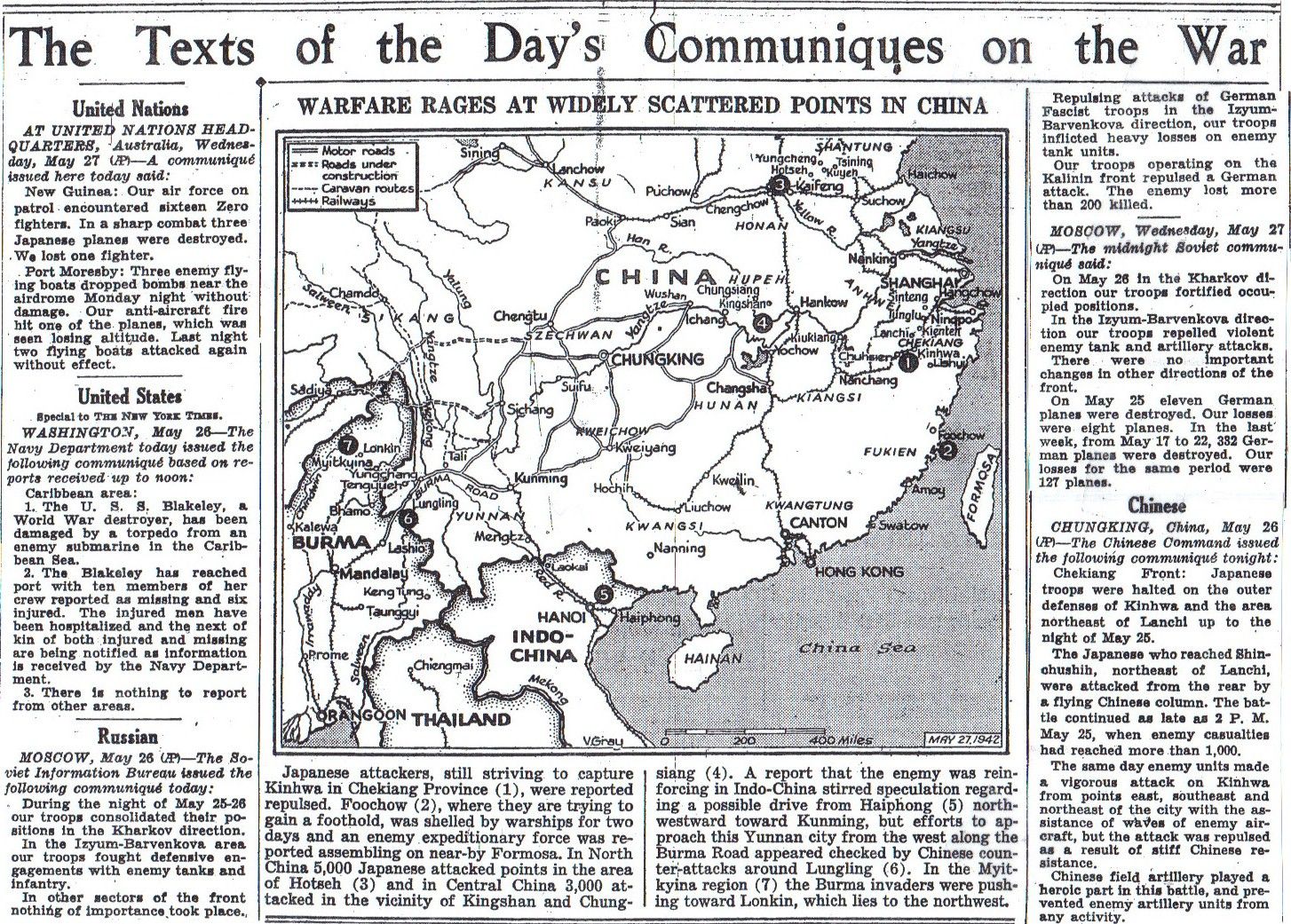
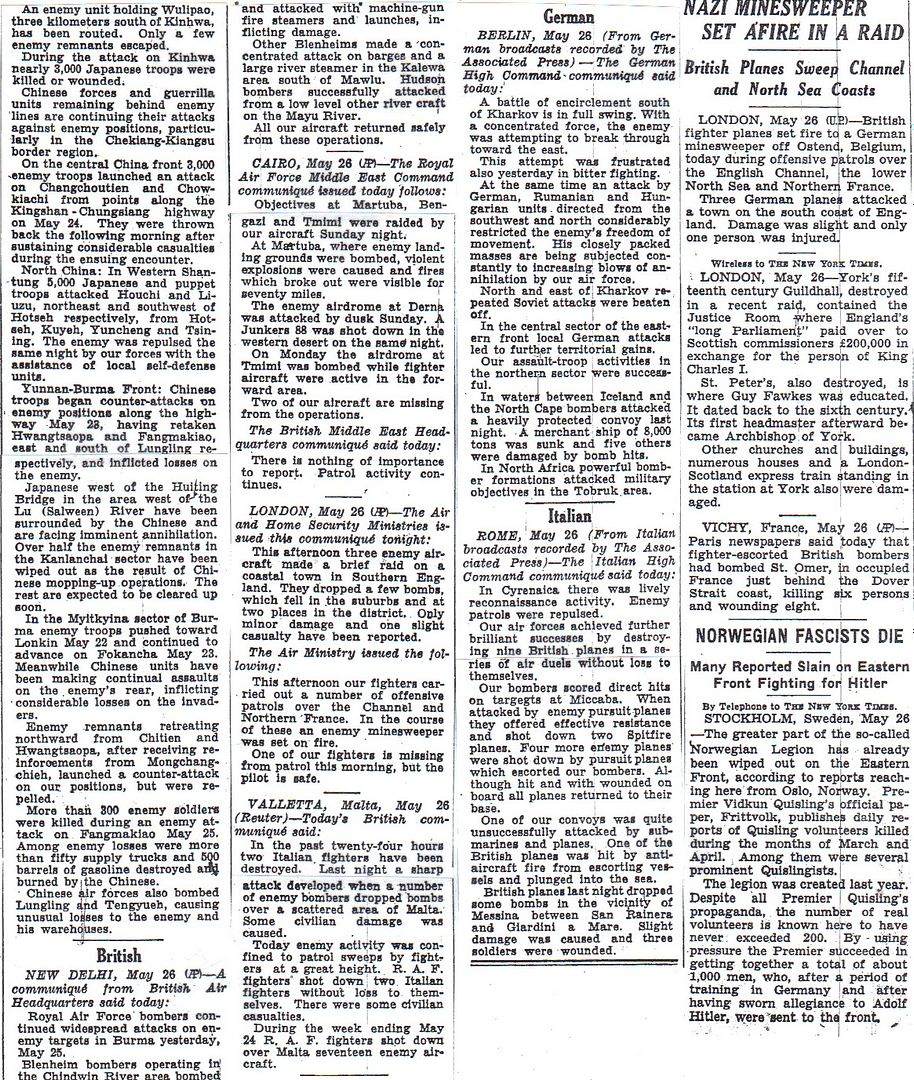
http://www.onwar.com/chrono/1942/may42/f27may42.htm
Czech resistance attacks Heydrich
Wednesday, May 27, 1942 www.onwar.com
Damaged Mercedes in which Heydrich was seated [Photo at link]
From Occupied Czechoslovakia... Local resistance fighters attempt to assassinate Reichsprotektor Heydrich in Prague with British supplied equipment. His injuries will prove fatal.
In the Central Pacific... The Japanese invasion fleet for Midway puts to sea from Saipan and Guam with troop transports carrying 5000 men. They are escorted by cruisers and destroyers. Likewise, the invasion force for the Aleutians sets sail in two groups from Ominato
In Hawaii... The damaged USS Yorktown arrives at Pearl Harbor and repairs begin immediately.
In North Africa... In various engagement with the British forces, Rommel’s army rapidly defeats the 3rd Indian and 7th Motorized Brigades. Losses are heavy on both sides, but the British can better sustain the loss of men and equipment. An Italian division fails to eliminate the Free French at Bir Hacheim.
http://homepage.ntlworld.com/andrew.etherington/frame.htm
May 27th, 1942
UNITED KINGDOM: ASW trawler HMS Arctic Pioneer sank after collision with battleship HMS King George V off Portsmouth.
Minesweeper HMS Parrsborough commissioned.
Minesweeper HMS Cadmus launched.
Destroyer HMS Myngs laid down.
HMC ML 079 and ML 082 commissioned.
Corvette KNM Montbretia (ex-HMS Montbretia) launched.
Corvette HMS Vetch launched.
ASW trawler HMS Coverley launched.
Rescue tug HMS Frisky launched. (Dave Shirlaw)
GERMANY: U-631 and U-632 launched. (Dave Shirlaw)
CZECHOSLOVAKIA: Prague: The dark-green Mercedes failed to appear at the usual time, and the four men waiting at the tram stop at the bottom of Kirchmayerstrasse began to worry. Trams came and went, collecting and setting down passengers. Time dragged by. At last look-outs, Josef Valcik and Adolf Opalka, gave the signal.
Jan Kubis and Josef Gabcik were at the corner, when the Mercedes appeared. Gabcik whipped a Sten gun from beneath his raincoat and aimed at the man in the front passenger seat: SS Obergruppenführer Reinhardt Heydrich, the deputy Reich “protector” of Bohemia and Moravia, also known as the “butcher of Prague”. The gun jammed; as the car went past, Kubis hurled a grenade.
It blew a huge hole in the bodywork. Heydrich and the driver climbed out. The four Czech resistance fighters, parachuted in from Britain for the assassination attempt, fled. Heydrich was now holding his back and staggering, clearly in great pain. Taken to hospital, he was found to have a bomb splinter in his spleen, a broken rib and pierced diaphragm.
NORTH AFRICA: Rommel’s panzers defeat the British 3rd Infantry and 7th Motor Brigades. The British however are better able to sustain the armour losses than the Germans.
LIBYA: The American Grant M3 tank makes its operational debut with the Eighth Army.
NETHERLANDS EAST INDIES: Timor: In order to supply the Australians holding out in the hills with their required 40 tons of supplies per month, the Australian navy takes over the job of resupply. Today the patrol vessel HMAS KURU (55 tons) arrives at a beach in Betano Bay on the south coast of East Timor, with ten tons of ammunition, medical supplies, food and clothing. It is unloaded at midnight. On her return trip KURU took some wounded men and David Ross (the British Consul General) who had escaped the Japanese in late May. (William L. Howard)(188, 189, 190, 191)
PACIFIC OCEAN: TF 6814, on New Caledonia, is redesignated as the Americal Division.
The Japanese Invasion Fleet sails from the Marianas toward Midway. A second invasion force heads for the Aleutians from Ominato.
U.S. Marines and Navy Seabees occupy the Wallis Islands in the southwest Pacific Ocean in position 13.18S, 176.10W. (Jack McKillop)
TERRITORY OF ALASKA: In the Aleutian Islands, the Japanese submarine HIJMS I-19 is preparing to launch a Yokosuka E14Y1, Navy Type 0 Small Reconnaissance Seaplane, Allied Code Name “Glen,” for a reconnaissance mission over Bogoslof Island, located in the Bering Sea about 60 miles (96.6 km) west of Unalaska Island, when a U.S. destroyer is sighted. The sub submerges causing irreparable damage to the aircraft.
Meanwhile, the submarine HIJMS I-25 launches a “Glen” to fly a reconnaissance mission over Kodiak Island in the Gulf of Alaska.
TERRITORY OF HAWAII: The USS Yorktown arrives at Pearl Harbor from the South Pacific. She limps into harbour trailing a ten-mile long oilslick.
CANADA: Corvette HMCS Louisburg launched Quebec City, Province of Quebec.
Minesweeper HMCS Lockeport commissioned. (Dave Shirlaw)
U.S.A.:
Minesweeper USS Swerve laid down.
Destroyer USS McCalla commissioned. (Dave Shirlaw)
ATLANTIC OCEAN: German Operation “Drumbeat” continues as U-502 sinks an unarmed U.S. freighter in the Caribbean enroute from Trinidad to Mobile, Alabama. (Jack McKillop)
At 2000 hours on 26 May, the unescorted Atenas spotted a periscope one point off the port beam about 175 miles south of the entrance to the Mississippi River. It moved slowly toward the vessel, so the master changed course so that the 4in stern gun (the only other guns on the ship were two .30cal guns) could be cleared and fired. After four shots on the periscope, it disappeared. The Atenas proceeded with southerly course in a zigzagging pattern. At 0400 on 27 May, U-106 began rapidly shelling the Atenas from about 2000 yards for about two minutes. Rasch tried unsuccessfully to bring down the radio antenna. Seven shells hit the port side and started two small fires but did little damage. There were no casualties among the eight officers, 46 men, eight armed guards and ten passengers. Again the master changed course and the stern gun fired at the U-boat. After the first shot, U-106 submerged and left the area. At daylight, the Atenas hove to while the holes in the hull were plugged. She continued on her voyage zigzagging constantly and arrived safely.
At 0319, the Athelknight, dispersed from Convoy OS-28, was torpedoed and sunk by gunfire by U-172 SE of Bermuda. Four crewmembers and five gunners were lost. The master, 39 crewmembers and three gunners were rescued - the master and 24 survivors after 28 days by the British merchantman Empire Austin and landed at Capetown; the second officer and 17 survivors landed on St. Bartholomew Island, Leeward Islands on 23 June, after sailing in a lifeboat for about 1200 miles.
At 1051, the unescorted USAT Jack (Master Serge Burrack) was hit by one torpedo from U-558 about 100 miles SW of Port Salut, Haiti. The torpedo struck on the starboard side between the foremast and #2 hold. The explosion opened a large hole in the hull, blew the hatch covers off, stopped the engines, and damaged the radio, the starboard lifeboat and a raft. The ship sank quickly within four minutes and the suction swamped the port lifeboat, which had been successfully launched. The badly damaged starboard boat was launched with two men. 14 survivors transferred into this boat from a raft. These survivors were picked up by submarine USS Grunion on 31 May and landed at the submarine base in Coco Solo on 3 June, after the submarine conducted a fruitless search for other survivors. Two armed guards and five crewmembers spent 32 days on a raft before being picked up. Five others on a makeshift raft were never seen again. 27 crewmembers, three armed guards and seven passengers of her complement of 43 crewmembers, nine armed guards and eight passengers (US Army personnel) were lost, including the master.
At 0018, the unescorted Polyphemus was hit in the stern by two torpedoes from U-578 about 340 miles north of Bermuda and sank by the stern at 0101. On 25 November, the ship had picked up 14 survivors from a lifeboat of Norland, which had been sunk by U-108 five days earlier. 15 Chinese crewmembers were killed in the explosions and the survivors abandoned ship in five lifeboats. The U-boat surfaced and questioned the first officer H. Brandenburg. He gave information about the name of the vessel and the cargo, but not the name of the port of destination. Some cigarettes and the heading for New York were given to the survivors before the U-boat left. Rehwinkel obviously did not like the Dutch master, because he wrote in the KTB “ein typisch vollgefressener Holländer.” The survivors in three lifeboats landed at Nantucket Island, Connecticut. The men in the two remaining boats were rescued by a Portuguese ship after one week and landed at New Bedford. One of these lifeboats had been spotted in grid CB 5757 on 29 May by U-566 and was provided with water and the actual position.
At 1103, the unescorted Hamlet was hit by one torpedo from U-753. The torpedo struck in the front part of the #10 tank. The engines were stopped and the guns manned, while the lifeboats were made ready for lowering. But the tanker did not sink and they tried to bring her to port. The radio antenna had been destroyed, so they had to rig up an emergency antenna, but before the work could be finished another torpedo hit at 1128. The ship now started to sink quickly and all crewmembers abandoned ship in the lifeboats. The men observed U-753 on the surface at this time. At 1142, a third torpedo struck between #13 and #15 tank, causing her to sink down to the poop deck. The boats stayed alongside the ship until daylight two hours later to make sure no more men were in the water, whereupon course was set for closest land. The poop of the tanker could still be seen in a 45° angle above the water. Three hours later, some fishing vessels took the lifeboats in tow and arrived Morgan City, Louisiana in the late evening. (Dave Shirlaw)
Soviet encirclementThe 25 May saw the first major Soviet attempt to break the encirclement. German Major General Lanz described the attacks as gruesome, made en masse. By 26 May, the surviving Red Army soldiers were forced into crowded positions in an area of roughly fifteen square kilometers. Soviet attempts to break into the German encirclement from the east were continuously blocked using tenacious defensive manoeuvres and German air power. Groups of Soviet tanks and infantry that attempted to escape and succeeded in breaking through German lines were caught and destroyed by Ju 87s from StG 77.[7] In the face of determined German operations, Timoshenko ordered the official halt of all Soviet offensive manoeuvres on 28 May, while attacks to break out of the encirclement continued until 30 May. Nonetheless, less than one man in ten managed to break out of the "Barvenkovo mousetrap".[6] Beevor puts Soviet losses in terms of prisoners as 240,000[6] (with the bulk of their armour), while Glantz citing Krivosheev gives a total of 277,190 overall Soviet casualties.[1][5] Both tend to agree on a low German casualty count, with the most formative rounding being at 20,000 dead, wounded and missing.[4][5][6] Regardless of the casualties, Kharkov was a major Soviet setback and it would put an end to the astonishing successes of the Red Army during the Winter Counteroffensive, and the smaller offensives of the spring.
Analysis and conclusions
Many authors have attempted to pinpoint the reasons for the debacle of the Second Battle of Kharkov. Several Soviet generals have placed the blame on the inability of Stavka and Stalin to appreciate the Wehrmacht's military power on the Eastern Front after their defeats in the winter of 1941–1942 and in the spring of 1942. On the subject, Zhukov sums up in his memoirs that the failure of this operation was quite predictable, since the offensive was organized very ineptly, the risk of exposing the left flank of the Izium salient to German counterattacks being obvious on a map.[43] Still according to Zhukov, the main reason for the stinging Soviet defeat lay in the mistakes made by Stalin, who underestimated the danger coming from German armies in the southwestern sector (as opposed to the Moscow sector) and failed to take steps to concentrate any substantial strategic reserves there to meet any potential German threat. Furthermore, Stalin ignored sensible advice provided by his own General Chief of Staff, who recommended organising a strong defence in the southwestern sector in order to be able to repulse any Wehrmacht attack.[43]
The men who attempted assainate Heydrich were NOT “local resistance fighters”. They were members of the Czech Army in exile, and were prachuted into Czechoslavakia, along with others, as part of Operation Anthropoid [or Arthropoid]. The operation was undertaken by the Czech government in exile under pressure from the British.
Disclaimer: Opinions posted on Free Republic are those of the individual posters and do not necessarily represent the opinion of Free Republic or its management. All materials posted herein are protected by copyright law and the exemption for fair use of copyrighted works.